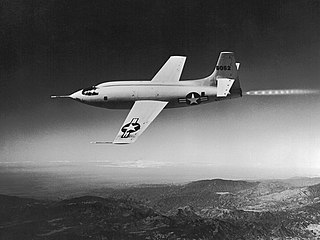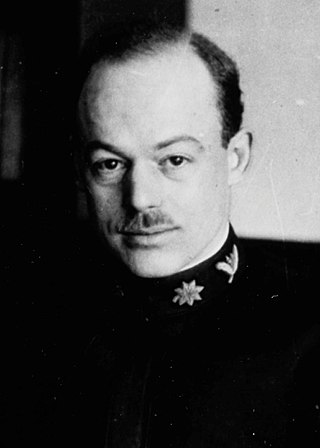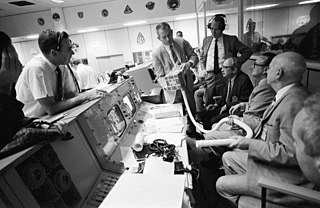Related Research Articles

Aerospace is a term used to collectively refer to the atmosphere and outer space. Aerospace activity is very diverse, with a multitude of commercial, industrial, and military applications. Aerospace engineering consists of aeronautics and astronautics. Aerospace organizations research, design, manufacture, operate, maintain, and repair both aircraft and spacecraft.

The National Advisory Committee for Aeronautics (NACA) was a United States federal agency that was founded on March 3, 1915, to undertake, promote, and institutionalize aeronautical research. On October 1, 1958, the agency was dissolved and its assets and personnel were transferred to the newly created National Aeronautics and Space Administration (NASA). NACA is an initialism, i.e., pronounced as individual letters, rather than as a whole word.

The Bell X-1 is a rocket engine–powered aircraft, designated originally as the XS-1, and was a joint National Advisory Committee for Aeronautics–U.S. Army Air Forces–U.S. Air Force supersonic research project built by Bell Aircraft. Conceived during 1944 and designed and built in 1945, it achieved a speed of nearly 1,000 miles per hour in 1948. A derivative of this same design, the Bell X-1A, having greater fuel capacity and hence longer rocket burning time, exceeded 1,600 miles per hour in 1954. The X-1 aircraft #46-062, nicknamed Glamorous Glennis and flown by Chuck Yeager, was the first piloted airplane to exceed the speed of sound in level flight and was the first of the X-planes, a series of American experimental rocket planes designed for testing new technologies.

Richard Travis Whitcomb was an American aeronautical engineer who was noted for his contributions to the science of aerodynamics.

The Robert J. Collier Trophy is awarded annually for the greatest achievement in aeronautics or astronautics in America, with respect to improving the performance, efficiency, and safety of air or space vehicles, the value of which has been thoroughly demonstrated by actual use during the preceding year.

The NASA Neil A. Armstrong Flight Research Center (AFRC) is an aeronautical research center operated by NASA. Its primary campus is located inside Edwards Air Force Base in California and is considered NASA's premier site for aeronautical research. AFRC operates some of the most advanced aircraft in the world and is known for many aviation firsts, including supporting the first crewed airplane to exceed the speed of sound in level flight, highest speed by a crewed, powered aircraft, the first pure digital fly-by-wire aircraft, and many others. AFRC operates a second site next to Air Force Plant 42 in Palmdale, California, known as Building 703, once the former Rockwell International/North American Aviation production facility. There, AFRC houses and operates several of NASA's Science Mission Directorate aircraft including SOFIA, a DC-8 Flying Laboratory, a Gulfstream C-20A UAVSAR and ER-2 High Altitude Platform. As of 2023, Bradley Flick is the center's director.

Robert Rowe Gilruth was an American aerospace engineer and an aviation/space pioneer who was the first director of NASA's Manned Spacecraft Center, later renamed the Lyndon B. Johnson Space Center.

Elbert Leander "Burt" Rutan is a retired American aerospace engineer and entrepreneur noted for his originality in designing light, strong, unusual-looking, and energy-efficient air and space craft. He designed the record-breaking Voyager, which in 1986 was the first plane to fly around the world without stopping or refueling. He also designed the Virgin Atlantic GlobalFlyer, which in 2006 set the world record for the fastest and longest nonstop non-refueled circumnavigation flight in history. In 2004, Rutan's sub-orbital spaceplane design SpaceShipOne became the first privately funded spacecraft to enter the realm of space, winning the Ansari X-Prize that year for achieving the feat twice within a two-week period.

The Douglas D-558-2 Skyrocket is a rocket and jet-powered research supersonic aircraft built by the Douglas Aircraft Company for the United States Navy. On 20 November 1953, shortly before the 50th anniversary of powered flight, Scott Crossfield piloted the Skyrocket to Mach 2, or more than 1,290 mph (2076 km/h), the first time an aircraft had exceeded twice the speed of sound.

The DFS 346 was a German rocket-powered swept-wing aircraft which began development during World War II in Germany. It was designed by Felix Kracht at the Deutsche Forschungsanstalt für Segelflug (DFS), the "German Institute for Sailplane Flight". A prototype was constructed but did not reach completion before the end of the war. It was taken to the Soviet Union where it was completed, tested and flown.

Albert Scott Crossfield was an American naval officer and test pilot. In 1953, he became the first pilot to fly at twice the speed of sound. Crossfield was the first of twelve pilots who flew the North American X-15, an experimental spaceplane jointly operated by the United States Air Force and NASA.

The Douglas Skystreak is an American single-engine jet research aircraft of the 1940s. It was designed in 1945 by the Douglas Aircraft Company for the U.S. Navy Bureau of Aeronautics, in conjunction with the National Advisory Committee for Aeronautics (NACA). The Skystreak was a turbojet-powered aircraft that took off from the ground under its own power and had unswept flying surfaces.

Moscow Aviation Institute is an engineering research university in Moscow, Russia. It is designated as a National Research University. Since its inception the institute has been spearheading advances in aerospace technology both within Russia and worldwide. The university laid emphasis on laboratory instruction in applied science and engineering, specific to the demands of aerospace industry.

Abraham "Abe" Silverstein was an American engineer who played an important part in the United States space program. He was a longtime manager at the National Aeronautics and Space Administration (NASA) and its predecessor, the National Advisory Committee for Aeronautics (NACA). He was instrumental in the planning of the Apollo, Ranger, Mariner, Surveyor, and Voyager missions, and named the Apollo program after the Greek and Roman God.

Jerome Clarke Hunsaker was an American naval officer and aeronautical engineer, born in Creston, Iowa, and educated at the U.S. Naval Academy and the Massachusetts Institute of Technology. His work with Gustav Eiffel outside Paris led to the first wind tunnel in the US at MIT. He was instrumental in developing a weather reporting and airway navigation. Hunsaker was also pivotal in establishing the theoretical and scientific study of aerodynamics in the United States. And he was primarily responsible for the design and construction of the Navy-Curtiss airplane (NC-4) that accomplished the first transatlantic flight, and the first successful shipboard fighter. Later he championed lighter-than-air flight but the loss of the Navy airship he designed, the USS Akron, led to the withdrawal of federal support. His WW2 chairmanship of the National Advisory Committee for Aeronautics (NACA) was notable for favouring the development of existing aircraft designs rather than experimenting with turbojets or missile technology.

The Bell XV-3 is an American tiltrotor aircraft developed by Bell Helicopter for a joint research program between the United States Air Force and the United States Army in order to explore convertiplane technologies. The XV-3 featured an engine mounted in the fuselage with driveshafts transferring power to two-bladed rotor assemblies mounted on the wingtips. The wingtip rotor assemblies were mounted to tilt 90 degrees from vertical to horizontal, designed to allow the XV-3 to take off and land like a helicopter but fly at faster airspeeds, similar to a conventional fixed-wing aircraft.

Aerospace engineering is the primary field of engineering concerned with the development of aircraft and spacecraft. It has two major and overlapping branches: aeronautical engineering and astronautical engineering. Avionics engineering is similar, but deals with the electronics side of aerospace engineering.
Paul Richard Hill (1909–1990) was a mid–twentieth-century American aerodynamicist. He was a leading research and development engineer and manager for NASA and its predecessor, NACA between 1939 and 1970, retiring as Associate Chief, Applied Materials and Physics Division at the NASA Langley Research Center. He is arguably most widely known today as the author of Unconventional Flying Objects: a Scientific Analysis.

Walter Charles Williams was an American engineer, leader of the National Advisory Committee for Aeronautics (NACA) group at Edwards Air Force Base in the 1940s and 1950s, and a NASA deputy associate administrator during Project Mercury.
References
- ↑ "Jenny Body". royalsociety.org. Retrieved 28 September 2019.
- ↑ "American Institute of Physics". Archived from the original on 2011-06-12. Retrieved 2010-08-29.
- ↑ "NASA - Parachutes—For Entire Airplanes".
- ↑ "Dwane L. Wallace - Kansapedia - Kansas Historical Society".